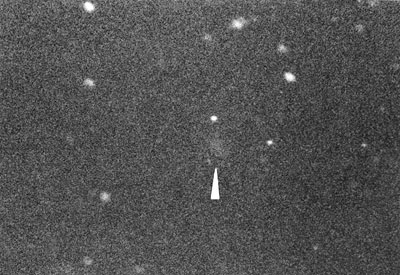A photograph of Comet Haneda-Campos
Where is the unlucky star Comet Haneda-Campos wandering in
space? Mr. Haneda had been searching for a comet inspired by my discovery
of Comet Ikeya Seki, using a home-built 9cm f/7 refractor as his comet
seeker, which was identical with my own comet seeker. In the fall of 1978
he discovered a new comet in the southern sky around the same time as Mr.
Campos in Africa discovered the same comet. Tokyo Astronomical Observatory
had already received a telegram reporting the discovery of Comet Campos
from IAU and Mr. Haneda's report came later. However, thanks to favorable
consideration by Smithsonian (CBAT), Mr. Haneda's name was given first
preceding Mr. Campos's name. Earlier, Mr. Kosai of Tokyo Astronomical Observatory
had asked me to verify Mr. Haneda's discovery. The appearance of Comet
Denning-Fujikawa after 97 years added to the excitement in 1978.
I found two photographic plates of Comet Haneda-Campos on
an old shelf in the bathroom. It was photographed by the 40cm f/5 comet
telescope. I also found the discovery photograph of Comet Tuttle-Giacobini-Kresak.
In those days my home-built comet telescope produced outstanding results.
D/1978R1(Haneda-Campos)
1978UT α(2000.0) δ m1
Oct.29.65764 02 24 26.02 -28 32 05.9 14.4 372
31.70069 02 32 49.15 -26 33 25.3 14.5 372
Comet Heneda-Campos on these photographic plates is hazy
and diffused without a nucleus or core. The comet's motion was very fast
because of its proximity to the earth and it is not difficult to imagine
how it was lost. The images taken by the 40cm telescope show that, too.
I tried to recover it from Geisei at its return several times using the
60cm reflector without any success. Probably the comet is usually very
faint, but at the time of the last discovery it might have been in outburst.
That particular night Mr. Haneda did not intend to go to
his observing site, but urged by his pet dog's barking, he went there and
discovered the comet. There is a similar story in a Japanese fairy tale,
in which a dog leads his elderly master to treasures with his barking.

D/1978 R1 (Haneda-Campos)
8-minute exposure from 0:45 on October 30, 1978 J.S.T.
40cm f/5 reflector, 103a-O photographic plate

